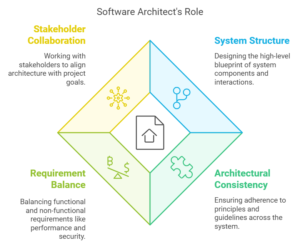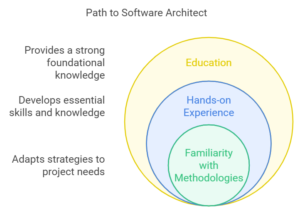
Unleash your potential as a software architect with our beginner's guide. Explore the key responsibilities, skills, and principles of architectural design, and set yourself on a path to creating robust and scalable software systems. Elevate your career in the dynamic world of software development.
In the world of software development, creating a well-structured, maintainable, and efficient system is crucial for success. This is where software architecture comes into play. Software architecture serves as the blueprint for a software system, defining its components, their relationships, and the overall structure.
As a key player in this process, the software architect holds a significant role in ensuring that a software project meets its functional requirements while maintaining quality and performance standards.
In this beginner’s guide, we will explore the concept of software architecture, its importance in the software development process, and the role of a software architect. We will also discuss common software architecture patterns and provide insights on how to become a successful software architect.
Understanding Software Architecture
What is software architecture?
Software architecture refers to the high-level structure of a software system. It encompasses the organization of the system’s components, their interconnections, and the principles and guidelines governing their design and evolution.
In essence, software architecture provides a roadmap for developers, helping them understand the system’s foundation and how its parts work together to achieve the desired functionality.
Importance of software architecture
Proper software architecture is vital for several reasons:
- Maintainability: A well-designed architecture makes it easier to update and modify the system as needed, reducing the time and effort required for maintenance.
- Scalability: Good architecture allows the system to grow and adapt to increasing demands without compromising performance or stability.
- Communication: The architecture serves as a common language among stakeholders, facilitating collaboration and decision-making throughout the development process.
- Performance and security: A robust architecture ensures that the system performs optimally and maintains the necessary security standards.
- Reduced development time and cost: With a clear architectural blueprint in place, development teams can avoid costly mistakes and complete projects more efficiently.
Common software architecture patterns
Several architectural patterns have emerged as best practices in the software development industry. Some of the most popular include:
- Layered (n-tier) architecture: This pattern organizes the system into a series of layers, each responsible for specific functionalities. It promotes the separation of concerns and modularity, making it easier to update or replace individual components.
- Microservices architecture: In this approach, the system is divided into small, independent services that communicate with each other. This enables greater flexibility, scalability, and fault tolerance.
- Event-driven architecture: This pattern revolves around the flow of events within the system, allowing components to react to specific occurrences. It supports asynchronous communication and can improve performance in certain scenarios.
- Domain-driven design: This approach focuses on modeling the system based on the underlying business domain, emphasizing collaboration between technical and non-technical stakeholders to create a shared understanding of the system’s requirements.
In the next section, we will delve deeper into the role of a software architect and the skills required to excel in this position.

The Role of a Software Architect
Responsibilities of a software architect
As the visionary behind a software system’s architecture, a software architect shoulders several critical responsibilities, including:
- Defining the overall structure of the system: The software architect designs the high-level blueprint for the system, determining its components, their relationships, and how they interact to achieve the desired functionality.
- Ensuring architectural consistency and integrity: A software architect must ensure that the chosen architecture is consistent across the system, adhering to established principles, guidelines, and constraints.
- Balancing functional requirements with non-functional requirements: While meeting functional requirements is essential, a software architect must also consider non-functional aspects such as performance, security, and maintainability, striking a balance between these competing concerns.
- Collaborating with stakeholders to achieve project goals: A software architect works closely with developers, product managers, and other stakeholders to ensure that the architecture aligns with the project’s objectives and meets the needs of end-users.

Key skills and knowledge for a software architect
To excel in the role of a software architect, one must possess a unique blend of technical expertise, soft skills, and domain knowledge. Some key attributes include:
- Strong technical background in software development: A deep understanding of programming languages, platforms, and development methodologies is crucial for designing effective software architectures.
- Familiarity with multiple programming languages and platforms: Proficiency in various languages and platforms allows a software architect to make informed decisions about the most suitable technologies for a given project.
- Understanding of architectural patterns and principles: A solid grasp of established architectural patterns enables a software architect to select and adapt the most appropriate solutions for specific problems.
- Excellent communication and leadership abilities: As a bridge between various stakeholders, a software architect must be able to communicate complex ideas effectively and guide the team toward a shared vision.
The software architect’s place in the development team
A software architect holds a pivotal role within the development team, encompassing a range of responsibilities that contribute to the project’s overall success.
One such responsibility is active collaboration with developers, product managers, and other stakeholders, ensuring that architectural decisions align with project goals and stakeholder expectations.
Furthermore, by providing a clear architectural vision, a software architect guides the development process, streamlining it to minimize the likelihood of costly mistakes and delays.
Additionally, given their wealth of experience and knowledge, software architects often act as mentors to junior team members, helping them grow and excel in their careers, and fostering a supportive and productive working environment.

Becoming a Software Architect
Required education and experience
There is no definitive, one-size-fits-all path to becoming a software architect. However, most professionals in this field share some common qualifications that contribute to their success.
Firstly, a formal education in computer science or related fields, such as a bachelor’s or master’s degree in computer science, software engineering, or a similar discipline, provides a strong foundation for a career in software architecture.
Secondly, hands-on experience in designing, building, and maintaining software systems is essential for developing the skills and knowledge required to become a successful software architect.
Lastly, familiarity with various software development methodologies, such as Agile, Scrum, and others, enables software architects to adapt their strategies to fit specific project needs, ensuring they can excel in diverse working environments.

Professional certifications and resources
Pursuing relevant certifications and continuing education can help aspiring software architects enhance their skills and credibility. Some popular options include:
- TOGAF (The Open Group Architecture Framework): A widely recognized certification for enterprise architects, covering best practices for designing and implementing software architectures.
- AWS Certified Solution Architect: This certification focuses on designing and deploying scalable, highly available, and fault-tolerant systems on the Amazon Web Services (AWS) platform.
- Microsoft Certified: Azure Solutions Architect Expert: A certification for professionals working with Microsoft Azure, demonstrating expertise in designing, implementing, and maintaining cloud-based solutions.
In addition to certifications, numerous books, online courses, and other resources can help you expand your knowledge of software architecture.
Tips for aspiring software architects
If you’re considering a career in software architecture, keep these tips in mind:
- Gain experience in multiple programming languages and platforms: Broadening your technical skills will enable you to make more informed decisions when designing software architectures.
- Develop strong problem-solving and critical thinking skills: These abilities are crucial for identifying and addressing the complex challenges that arise during the architectural design process.
- Stay updated on industry trends and emerging technologies: As the world of software development continues to evolve, staying abreast of new trends and technologies will help you remain competitive and innovative in your field.
- Network with professionals in the field: Connecting with experienced software architects can provide valuable insights, mentorship, and opportunities for career growth.
Conclusion
Understanding the importance of software architecture and the role of a software architect is essential for anyone aspiring to excel in this dynamic field. By acquiring the necessary skills, education, and experience, you can embark on a rewarding career in software architecture and play a vital role in shaping the future of software development.
Ready to innovate and transform your business? Say hello to CodeBeavers!
If you are looking for ways to bring your product or app ideas to life? We’ve got your back. CodeBeavers has the tools and engineers you need to make your projects come alive. With CodeBeavers, you’ll be able to build faster than ever, deploy code with ease, and scale like never before. Send us your requirements now, and let’s start winning together.




